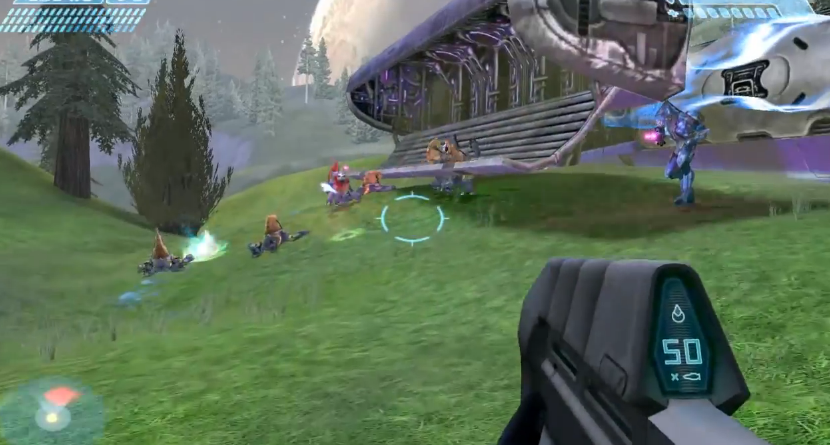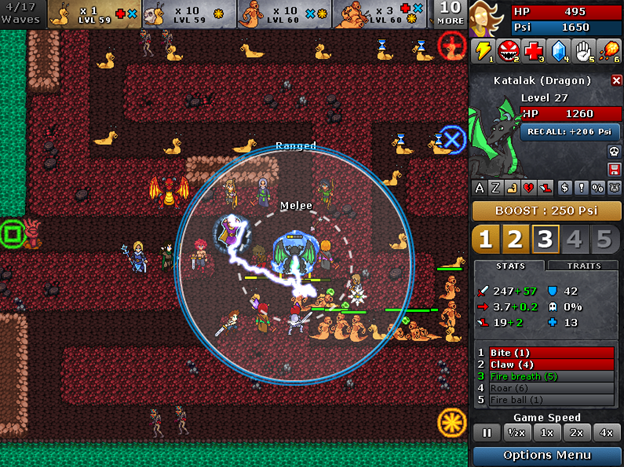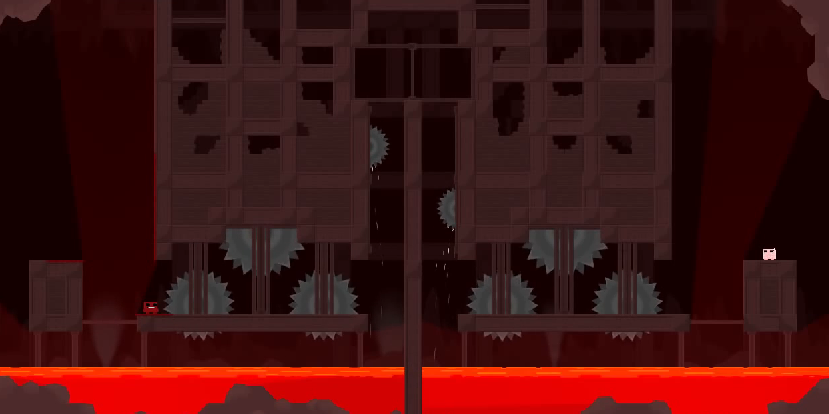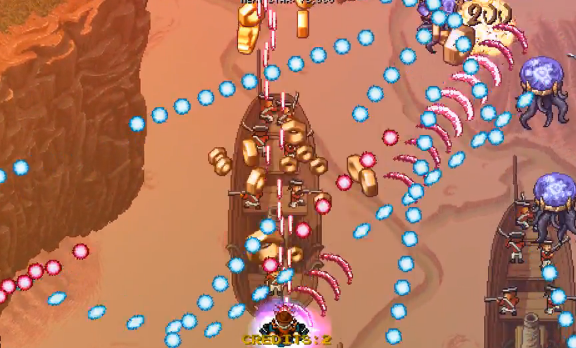Part 4: The Set Piece Period
The third era of videogame design, the set-piece period, began around 1998 or 1999. Unlike the beginning of the previous two eras of videogame design, there was no one watershed idea that spread suddenly, changing the industry as a whole. Rather, new design trends slowly developed as Japanese game design ideas came into contact with Western software production methods. Videogames are, after all, a kind of software, and software production had seen enormous development in the business world. It was inevitable that as the videogames market expanded and production teams grew, corporations would apply extant software production methods to the game-making process. This is not to say that videogames before 1998 were designed without respect to business or technology limitations. The practical aspects of development have affected videogame design from the very beginning. The very invention of the axis of obstacles came about because of a technological shortcoming, a moment of serendipity that changed videogames forever. Years after that, Nintendo designers pioneered the use of composite games, but in order to do so they had to have a game console that was actually powerful enough to support the many, long levels made possible by composite design. These considerations, however, are largely technological. What the Western boom in videogame production did was to change how team members worked, especially in the way the role of lead and subordinate designers changed.
It is important to note that the practice of composite design never died out in the way arcade design eventually did. There are plenty of small and mid-sized design studios still churning out composite games today. Even the largest and most business-conscious development studios still make composite games frequently, especially in the Japanese market. Often a game can be a composite game in its central mechanics, but a set-piece game in its execution. The reason for this is that there are significant design changes in a set-piece game that stem from production techniques, even if the core concept is for a composite game. The techniques in question are all based in the content pipeline, which was derived from non-game software development practices. The original idea is that in a software team there is one lead developer with a very high level of skill, and then under him or her are several more junior developers. The lead developer does not work directly on the product; rather, he or she creates code-based “tools” that the junior developers use to create the many visible facets of their software. The senior developer has a very high degree of skill, many years of experience, and is often hand-picked for the job. The senior developer is there to solve the big, far-reaching problems like code architecture, standards and such. The junior developers are more fungible; with the tools they have been given by the senior developer, they solve much simpler tasks. The junior developers do the slightly more tedious coding activities that involve numerous, repeated implementations of the tools that the senior developer has created.
Videogame producers saw the effectiveness of this programming pipeline and began to experiment with doing design and art the same way. A good way to visualize this structure is to divide tasks into invention and implementation.

This structure was created for business reasons, but it had an impact on the design of games made this way. One of the logistical perks of the content pipeline is that lower-level personnel were scalable and fungible. Junior developers and level designers can be moved into or out of the project quickly, making it easy to scale up or scale down the production. The fundamental concepts of a project’s design are so well-developed before level design even begins that, in this production scheme, it’s hard for the level designers to deviate too much from the master plan. Thus, they’re replaceable in a way that earlier game developers were probably not. This doesn’t mean that the senior personnel on a project are responsible for all the good ideas. Many good suggestions do go back up the pipeline for the lead designer to consider. Still, junior designers in a content pipeline generally can’t try their new ideas without having to go up the chain of command to a superior who is occupied with many other things, instead of bringing those ideas to a team member who works with them every day and can help try them out right away. So while lower-level developers can help create new game design ideas, it’s harder for them to do that, and so it will probably happen less frequently. After the mechanics are set from above, most of the remaining game design effort is spent on calibrating the challenges within a narrow range of variables.
This highlights the biggest impact that the content pipeline had on game design, and one of the reasons why set piece design diverged from composite design. Several Japanese developers of the composite and arcade eras have said that experimentation, failure and serendipity led to their best ideas. Both Japanese design teams and earlier, small American studios enjoyed creative latitude of a different sort than their content-pipeline peers. The difference is in qualitative freedom vs quantitative freedom. Close-knit, small teams of the composite era found that the best way to make a game both coherent and challenging was to use persistent qualitative changes. Designers didn’t need to constantly increase the distance between platforms, or the speed of enemy projectiles, or even the number of enemies on screen at the same time. Instead, the hardest parts of those games tended to be qualitatively complex, rather than quantitatively abusive. Platforms moved with increasingly intricate behaviors, projectiles came in more varied and more complicated patterns, enemies appeared in situations that embellished their behavior, but not necessarily in greater quantity or at greater speed. At the end of a composite game, all of those things would overlap in novel ways. Thus, the complexity of the games would come from mixing and matching ideas in which the player was already fluent, creating situations that seemed new yet familiar.
Because of the top-down nature of the content pipeline, the junior devs and designers within it didn’t have the experimental latitude to make the kinds of intricate, recombinant challenges that composite design teams did. In order to be able to have interchangeable designers and developers working in separate silos, those artists had to rely on the design formation we call set pieces. Set pieces are discrete chunks of content spaced across a level of a game in such a way that they have minimal impact upon one another. The outcome of set-piece 2-1 doesn’t really change the starting conditions of set pieces 2-2, or 2-3, etc. Designers of set pieces use things like regenerating health and large caches of ammo between set pieces to make sure that the player is always starting each new set piece “fresh.” This means that the same designers don’t have to be working on sequential set pieces. The designer working on set piece 2-2 can simply tell the designer of set piece 2-3 that there are fourteen enemy soldiers, two enemy tanks, six chest-high walls, and a rocket launcher. The designer of 2-3 can then finish his or her set piece before 2-2 is even fully complete. All the designer of 2-3 has to know before hand is whether or not 2-3 needs to be harder or easier than 2-2. If it’s harder, he or she increases the number of soldiers and tanks, and/or decreases the number of chest high walls. Or they can simply swap out three normal soldiers and put in three red “elite” soldiers who have more HP and deal more damage. The focus is on quantitative changes, because those are the easiest to implement, easiest to quickly communicate to other members of the design team, and the easiest to iterate with stylistic consistency.
The original HALO serves as a good example of this trend. When HALO originally came out, many people wrote about how baffled they were at the design of the single player levels. Compared to shooters of the 90s, there are remarkably few types of enemies in the game, and even fewer in the first half. A platformer or puzzle game can get away with having few enemies because there’s so much else that goes into it. HALO doesn’t have those advantages, so the fact that it has vastly fewer unit types than Doom or Half-Life made its single player campaign seem odd among mainstream shooters. Obviously, the multiplayer is the real focus of the HALO franchise, but they did make a single player campaign for every game. There are plenty of instances of quantitative pressures in the campaign that make the few enemies the designers do use more interesting. The second level of that campaign shows just one of several mechanisms the designers used to propel the challenges.

During the defense of an occupied structure, enemy units come at the player in waves on drop-ships. Here, the designer has lots of numerical knobs to turn in order to scale the difficulty up or down. The drop-ships can carry more or fewer enemies. The drop-ships can come at greater frequency. The drop ships can be spaced more widely across the map so that the total danger area is increased. Both across the course of a single campaign and across difficulty settings, these variables keep rising. The junior level content-creators don’t have to take risks or experiment with overlapping mechanics (although they can if they're allowed), they simply plug in the right number of pieces. There’s definitely some creativity in that process; the HALO designers used terrain creatively to make a few very interesting moments. Ultimately, though, terrain could only be used so many ways without introducing new mechanics, and quantitative changes were the bedrock upon which the game was built.
You may recognize an underlying pattern that results from a succession of highly quantitative set pieces: the axis of obstacles has returned to prominence. The easy quantitative adjustments across set pieces naturally focus on movement along the axis of obstacles, and see less use of the axis of abilities. This doesn't mean that set-piece games are really arcade games in disguise, because they aren't. Games of the arcade era tended to move along the axis of obstacles through the use of one or two variables, like number of enemies and enemy speed. Set piece games tend to adjust significantly more variables than that, but they do adjust them in the same way. Also, as I said earlier, set piece games can and do blend composite techniques into their design in one way or another. The design of set piece games just tends to recall the arcade era in its heavier reliance on quantitative methods for increasing the difficulty of the game over time.
As a quick answer to note an objection I’m sure some of you have: it’s not just shooters that do this kind of set piece design. Shooters adhere to this formula more frequently than other genres, but perhaps not more intensely. The genre which adheres to set pieces the most intensely is the MMORPG genre. Many of you have done max-level raids and dungeons in an MMO; generally those instances consist of discrete encounters with packs of enemies and (more importantly) bosses. In some raids, there aren’t even any trash-mob set pieces in between bosses. Hardcore players of the MMO genre will often spend the majority of their play doing max-level content repetitions, fighting the same set pieces dozens or even hundreds of times. Many of these players eventually get burnt out on MMOs and find themselves unable to ever meaningfully participate in an MMO ever again, because of this endless succession of quantitatively-driven repeitions.
Indie Games and Game Design History
Interestingly, one of the effects of escalating budgets and conservative franchise re-hashes is that there is an increasingly large amount of game development occurring outside of the corporate mainstream. Indie games are growing at an incredible rate, thanks largely to digital distribution services like Steam, Desura and Newgrounds (and now Epic, Humble and other storefronts). Now that a four-man team can spend a year or two making a game, and then sell half a million copies of it digitally, it is both possible and (sometimes) profitable to make indie games. One of the results of this is a wave of new and interesting composites. The indie game Defender’s Quest, for example, combines the JRPG level and equipment system with tower defense objectives.

It seems unlikely that a major AAA studio would ever risk making a game like this, but it does prove that composite design techniques are still useful and vital. There are many other games just like this that are making innovative composites that focus on gameplay rather than flashy presentation.
There’s another side to the indie revolution, though, which mirrors some of the trends in set piece design. I want to state up front that this trend does not describe all or even most of indie games; indie games are very diverse, and that’s why they’re interesting. But there is definitely a prevalent trend in indie games to serve an ultra-hardcore niche through the use of arcade-style design. Arcade games flourished in the late 1970s and early 1980s, but videogames in general suffered a huge drop-off in interest until the emergence of Nintendo and its composite designs. Some of this was just the newness of videogames wearing off and killing the fad, but some of it had to do with the natural consequences of the design of arcade games. Arcade games tend to move up the axis of obstacles by tweaking just a few variables. For all but the most hardcore audiences, this can become frustrating and boring, the two greatest sins of game design. With hundreds of millions of gamers in the market, however, it has become possible to serve a niche as a business model. Especially with the rise of cheap production and digital distribution, niche titles can be made sustainably.
The best example I can think of is the Meat Boy series. Super Meat Boy in particular takes platforming difficulty to great extremes while employing only the most basic elements composite design. Composite design has left an indelible mark on all platformers everywhere, but the Meat Boy titles are very much about their ever-steepening axis of obstacles.

The game never stops demanding more speed, dexterity, better timing and simple trial-and-error learning. These are all the hallmarks of an arcade-style game. For the audience who is thrilled by the punishing difficulty, this is great. It doesn’t matter that the greater commercial market doesn’t buy into it—they don’t need to. In fact, there’s a whole genre of games which use the arcade style and are flourishing in the indie market. The bullet hell subgenre of shoot-em-ups is probably the purest modern incarnation of that punishing axis of obstacles. Depending on your opinion, you could say the whole shmup genre is in the arcade style, but the modern bullet hell niche is especially so.

The developers of Jamestown left their jobs at AAA companies specifically so they could make games like this—titles without mass-market appeal. The design, though elegant, is rather Spartan and very punishing. Moving between levels and difficulty settings it becomes clear just how numerically-oriented the game’s difficulty is. This is an arcade game without the quarters, made possible by the growing audience of games and digital distribution.
The Future
The future of videogame design is difficult to predict. Not too long ago many people thought that social games (Zynga in particular) would come to completely dominate the market. That hasn’t happened. There is some evidence of a cyclical pattern in game design, although projecting that pattern into the future is admittedly questionable. Still, now that many set piece games and indie games have reclaimed the central feature of the arcade style of design, it wouldn’t be surprising to see this neo-arcade period peak and then fall off, followed by a new wave of composite designs. Thanks to the proliferation of digital distribution, new pricing models and robust game-making tools for amateurs and semi-professionals, indie games are on the rise. Indie games are more likely to employ new or experimental game design ideas, since they have no conservative corporate oversight. As such, it is likely that the next great flourishing of new IPs (i.e. the next great series) will come when designers take bold, fresh ideas from niche indie games and recombine them to create mainstream composite titles. After the publication of the next Reverse Design, I’m hoping to do a series of shorter articles on some new game design ideas that have become prevalent in the last few years.
The point of these articles is to serve as an introduction that will make it easier to understand the historical context of Reverse Design: Super Mario World. Super Mario World is an amazing example of composite design at its best, and concretely illustrates many of the points made in this article. At some point, I’m hoping to create an entire textbook based on videogame design history that will be used at the university level. The Reverse Design series is a first step in that direction, providing much of the primary research into games that should form the basis of any theory. The hope is that game design majors will be able to learn game design through history the same way that music students learn through music history, or film students from film history—and so on. There may be another Kickstarter somewhere down the road for this, after the rest of the Reverse Design series has been published.
Reverse Design: Super Mario World should be online in the next few weeks after it gets back from our editors. Until then, feel free to shoot questions or comments about this article to me on Twitter @tgdfweb or through the submissions link.
(Some image credits: the Trinexx shot comes from Zeldapedia, and the Doom 2 HUD from Wikipedia, although the image has moved out since borrowing.)